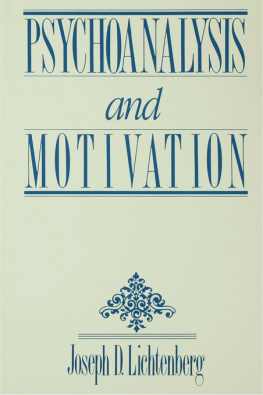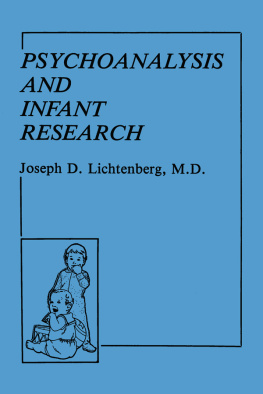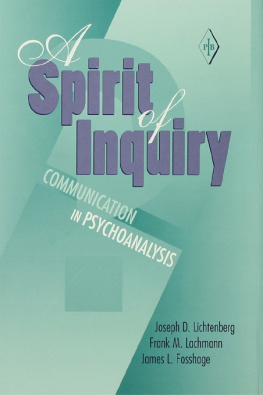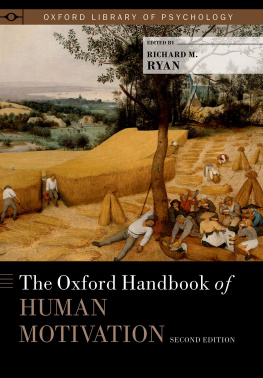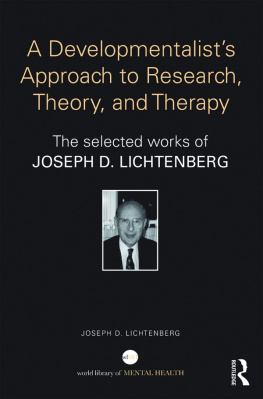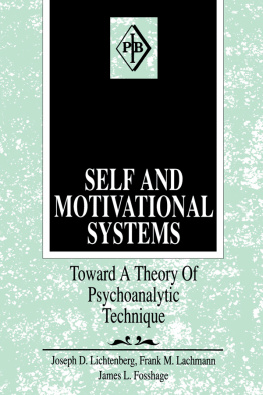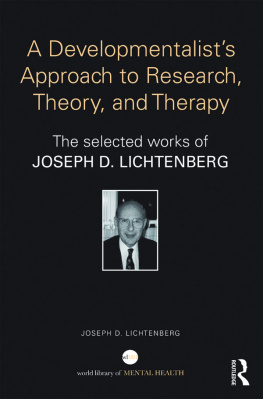
Psychoanalysis
and
Motivation


Psychoanalytic Inquiry Book Series
Volume 1
Reflections on Self PsychologyEdited by Joseph D. Lichtenberg, M.D. & Samuel Kaplan, M.D.
Volume 2
Psychoanalysis and Infant ResearchJoseph D. Lichtenberg, M.D.
Volume 3
Empathy I & IIEdited by Joseph D. Lichtenberg, M.D., Melvin Bornstein, M.D. & Donald Silver, M.D.
Volume 4
Structures of Subjectivity: Explorations in Psychoanalytic PhenomenologyGeorge E. Atwood, Ph.D. & Robert D. Stolorow, Ph.D.
Volume 5
Towards a Comprehensive Model for Schizophrenic Disorders: Psychoanalytic Essays in Memory of Ping-Nie Pao, M.D.Edited by David B. Feinsilver, M.D.
Volumes 6 and 7
The Borderline Patient: Emerging Concepts in Diagnosis, Psychodynamics, and Treatment, 1 & 2Edited by James S. Grotstein, M.D., Marion F. Solomon, Ph.D. & Joan A. Lang, M.D.
Volume 8
Psychoanalytic Treatment: An Intersubjective ApproachRobert D. Stolorow, Ph.D., Bernard Brandchaft, M.D. & George E. Atwood, Ph.D.
Volume 9
Female Homosexuality: Choice Without VolitionElaine V. Siegel, Ph.D.
Volume 10
Psychoanalysis and MotivationJoseph D. Lichtenberg, M.D.
Psychoanalysis
and
Motivation

Joseph D. Lichtenberg
with a contribution by
June L. Hadley

1989 The Analytic Press, Inc.
101 West Street
Hillsdale, NJ 07642
www.analyticpress.com
All rights reserved. No part of this book may be reproduced in any form, by Photostat, microform, retrieval system, or any other means without prior written permission of the publisher.
First paperback printing 2001
Set in Palatino type
Library of Congress Cataloging-in-Publication Data
Lichtenberg, Joseph D.
Psychoanalysis and motivation I Joseph D. Lichtenberg: with a contribution by June L. Hadley
p. cm. - (Psychoanalytic Inquiry Book series: v 10)
Includes bibliographies and index
ISBN 0-88163-358-5
1. Motivation (Psychology) 2. Psychoanalysis 3. Developmental psychology 4 Self psychology. I. Hadley, June L. 1. Title. III. Series. [DNLM: 1. Motivation. 2. Psychoanalytic therapy. Wl PS427F v. 10 / BF 503L699p]
RC489.M655L,531988
153.8-dc79
DNLM / DL C
for Library of Congress
8F.-370Z-5
C1P
Printed in the United States of America
10 9 8 7 6 5 4 3 2 1
Contents
June Hadley
Acknowledgments
My debts are many. The fundamental idea of the five motivation systems, the core matrix of this book, is mine, but, as a quick survey of the reference list will attest, the research and observations I integrate are to a great extent the work of others. Besides the brilliance of their specific research, colleagues such as Mary Ainsworth, Louis Sander, Daniel Stern, Gerald Stechler, Linda Gunsberg, Robert Emde, and Henri Parens have guided me through the intricacies of neonatal and infant experimental studies. My broader conceptual debt begins with Freud, Hartmann, Spitz, Rapaport, and teachers like Margaret Mahler and Annemarie Weil, from whom I learned to relate experience with theory. More immediately, I am deeply appreciative of those colleagues with whom I have shared the adventure of an investigation of the self under the inspiration of Heinz Kohut: Ernest Wolf, Michael Basch, Arnold Goldberg, Marian and Paul Tolpin, Anna and Paul Ornstein, Daphne and Robert Stolorow, Frank Lachmann, James Fosshage, Estelle and Morton Shane, Naomi and Arthur Malin, Jules Miller, Howard Bacal, Bernard Brandchaft, and Alan Kindler.
Writing a book, like raising a child, flourishes within the matrix of a supportive family. I am remarkably fortunate that my family members provided me not only with needed encouragement and the patience to abide my physical and psychological absences, but also with concrete facilitating support: my wife, Charlotte, as editor, advisor, and impeccable critic; my children, Ann Lichtenberg Shofer, as educator, increasing my knowledge of learning disabilities, Maryland Pao Holland, as physician, keeping me abreast of new knowledge in pediatrics, and Amy Lichtenberg and William Pao, for a thousand little helpful tasks performed with kindness.
I have been extremely fortunate in having a group of friends on whom to call to read a chapter critically and advise me on its logic and clarity: Lawrence Friedman, John Gedo, Warren Poland, and Rosalea Schonbar. Most of the clinical vignettes I include here are from my own clinical practice. For other, illuminating clinical examples, I am grateful to Etta Levinson, Douglas Chavis, and Anna Ornstein. June Hadleys chapter on neurobiology adds a dimension to my conception, and Andrew Schwartz has helped me to understand more of this burgeoning field of information. Likewise, Leon Wurmser, Donald Nathanson, and Virginia Demos have added to my knowledge of affects. Donald Silver and Melvin Bornstein, my co-editors of Psychoanalytic Inquiry for so many years, are constant sources of thoughtful suggestions, encouragement, and appreciation. Other colleagues and organizations provided opportunities for me to present my ideas in their formative stages to audiences and discussants who could point out to me contradictions that required me to think through problems. This opportunity enabled me to expand my conceptions and grow more certain of their cogency. I wish to thank Lotte Kohler, Peter Kutter and Janos Paul in Frankfurt, Victor Schirmer in Philadelphia, and the American Psychoanalytic Association and the National Council of Self Psychology.
Paul Stepansky of The Analytic Press has been understanding in his encouragement as well as a valued advisor. Eleanor Starke Kobrins copy-editing has helped to make the text much more readable.
My final debt is to my patients, to those people whose faith in my intent to help restore their disturbed physiological regulation, impaired sense of intimacy, reduced sense of efficacy and competence pleasure, overreliance on antagonism and fear, and reduced capacity for sensual pleasure and sexual excitement permitted them to work with me over the 40 years I have spent in this field. They are, and have been, my ultimate teachersinspiring me to try to understand the motives in the baby and developing child in all of us.
Preface
Psychoanalysis and Motivation asks a good deal of the reader. My goal is to deal with the heart of what we know about motivation and, by taking a fresh look at underlying motivational systems, to extend our understanding. To follow my presentation, the reader is asked to become familiar with new terms, selected to avoid conceptual pitfalls and metapsychological artifacts carried by more familiar designators of dual drive theory. I have chosen such terms as physiological regulation, attachment, affiliation, exploration, assertion, aversion, antagonism, withdrawal, sensual, sexual, and model scenes as broad designators, while attempting to preserve intact the evocativeness of their conventional nontechnical meanings. Naturally, I have not coined these terms or initiated their technical use. Thus I ask the reader to follow, in each chapter on the systems (), discussions that begin with prior usages and then take up the approach I offer, the research and observations with which I support my contention and the clinical examples I provide to bear out these usages.
Next page
